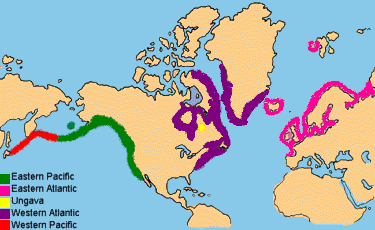 SKC Films Library SKC Films Library |
| SKC Films Library >> Science >> Zoology >> Mammals >> Order Carnivora >> Family Phocidae |
| Harbor Seal Phoca vitulina Description The coat of a harbor seal is spotted in shades ranging from silver-gray to black to dark brown, and the spot pattern is unique to each individual seal. Harbor seals are five to six feet in length and weigh up to 300 pounds, with males being slightly larger than females. Distribution and Habitat Harbor seals inhabit the temperate, subarctic, and arctic waters of the North Atlantic and Pacific coasts. There are five subspecies, each common to a specific coastal region. The Eastern Atlantic Harbor Seal inhabits the western coast of Europe as far north as the Scandinavian Peninsula, the British Isles, and Iceland. The Western Atlantic subspecies is found in the eastern Canadian Arctic and southern Greenland, south to the coast of New Jersey. The Eastern Pacific Harbor Seal ranges from the Pribilof and Aleutian Islands south to Baja California. The Western Pacific subspecies ranges from the western Aleutian and Commander Islands to the Kuril Islands and Hokkaido, Japan. The most restricted subspecies, known as the Ungava Seal, is found only on the freshwater lakes and rivers of the Ungava Peninsula in northern Quebec. The Ungava is the only known harbor seal to live in freshwater year round. Regardless of subspecies, an individual harbor seal will typically spend its entire life along the same stretch of coastline. Although they do not migrate, harbor seals will occasionally travel in search of food, but almost always return to their "homeland" afterward.
Reproduction Breeding season varies according to habitat and environmental conditions, with mating taking place anytime from late winter to mid autumn. Harbor seals typically return to the same breeding grounds each year. Male courtship behavior consists of chasing, neck and flipper biting, and embracing. Mating takes place in the water. Males typically mate with several females during the breeding season, but females usually only mate with one male per season. A single pup (very rarely twins) is born after a gestation period of about ten months. The pup can crawl and swim almost immediately after birth, and is weaned at three to six weeks. Harbor seals are sexually mature at three to seven years of age, with females maturing earlier than males. Harbor seals can live up to 25 years in the wild. Diet The specific diet of a harbor seal depends on the region and season, but generally consists of fish, cephalopods, mollusks, and crustaceans. Ungava Seals feed exclusively on freshwater fish. Most feeding takes place close to shore or in shallow waters, but harbor seals can dive for food and stay submerged for several minutes. Scientific Classification phylum Chordata SOURCE |
| SKC Films Library >> Science >> Zoology >> Mammals >> Order Carnivora
>> Family
Phocidae This page was last updated on June 12, 2017. |
